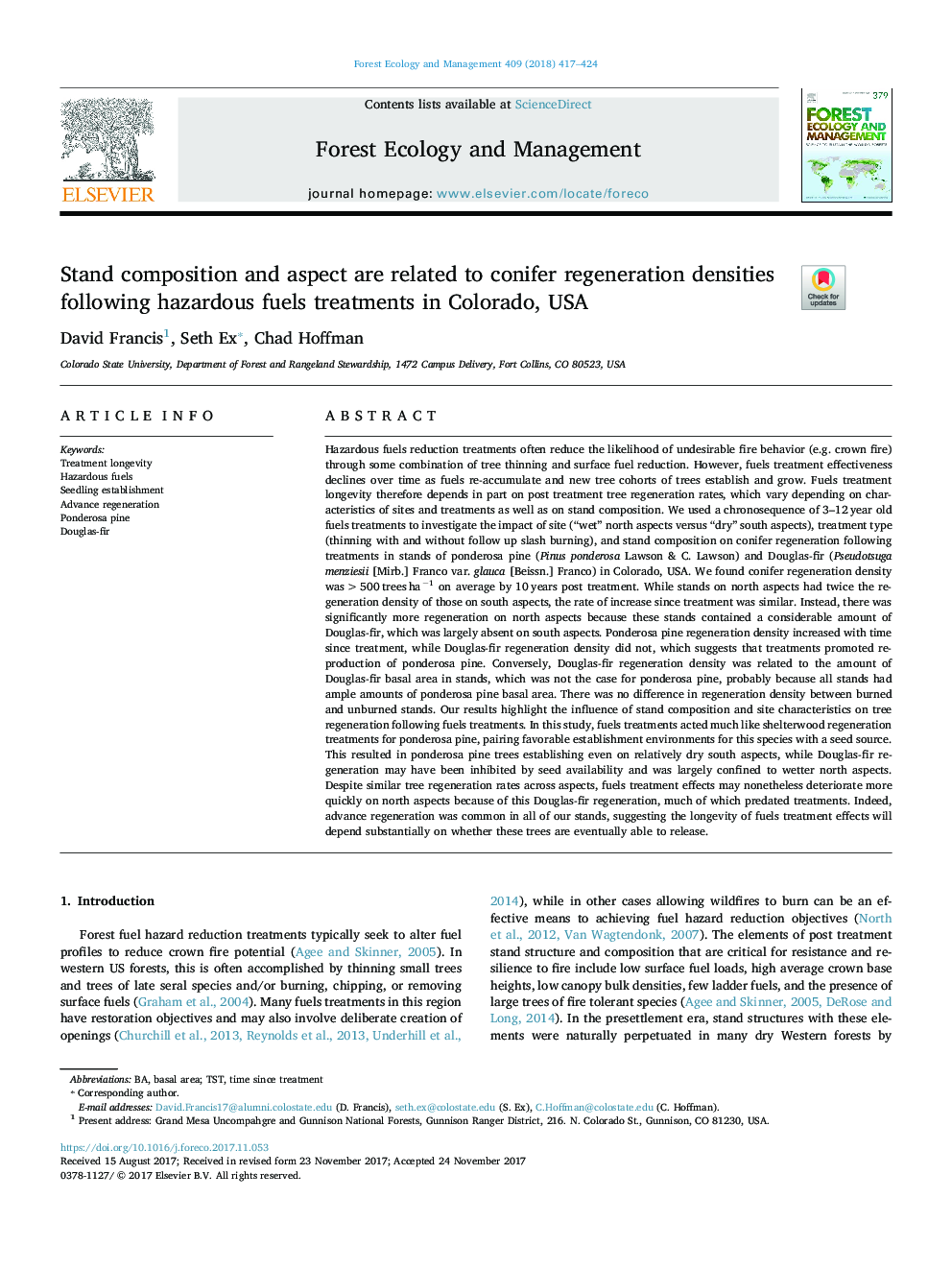| کد مقاله | کد نشریه | سال انتشار | مقاله انگلیسی | نسخه تمام متن |
|---|---|---|---|---|
| 6541924 | 1421349 | 2018 | 8 صفحه PDF | دانلود رایگان |
عنوان انگلیسی مقاله ISI
Stand composition and aspect are related to conifer regeneration densities following hazardous fuels treatments in Colorado, USA
ترجمه فارسی عنوان
ترکیب و جنبه مربوط به تراکم بازسازی مخروطی پس از درمان سوخت های خطرناک در کلرادو، ایالات متحده آمریکا است
دانلود مقاله + سفارش ترجمه
دانلود مقاله ISI انگلیسی
رایگان برای ایرانیان
کلمات کلیدی
موضوعات مرتبط
علوم زیستی و بیوفناوری
علوم کشاورزی و بیولوژیک
بوم شناسی، تکامل، رفتار و سامانه شناسی
چکیده انگلیسی
Hazardous fuels reduction treatments often reduce the likelihood of undesirable fire behavior (e.g. crown fire) through some combination of tree thinning and surface fuel reduction. However, fuels treatment effectiveness declines over time as fuels re-accumulate and new tree cohorts of trees establish and grow. Fuels treatment longevity therefore depends in part on post treatment tree regeneration rates, which vary depending on characteristics of sites and treatments as well as on stand composition. We used a chronosequence of 3-12â¯year old fuels treatments to investigate the impact of site (“wet” north aspects versus “dry” south aspects), treatment type (thinning with and without follow up slash burning), and stand composition on conifer regeneration following treatments in stands of ponderosa pine (Pinus ponderosa Lawson & C. Lawson) and Douglas-fir (Pseudotsuga menziesii [Mirb.] Franco var. glauca [Beissn.] Franco) in Colorado, USA. We found conifer regeneration density was >500â¯treesâ¯haâ1 on average by 10â¯years post treatment. While stands on north aspects had twice the regeneration density of those on south aspects, the rate of increase since treatment was similar. Instead, there was significantly more regeneration on north aspects because these stands contained a considerable amount of Douglas-fir, which was largely absent on south aspects. Ponderosa pine regeneration density increased with time since treatment, while Douglas-fir regeneration density did not, which suggests that treatments promoted reproduction of ponderosa pine. Conversely, Douglas-fir regeneration density was related to the amount of Douglas-fir basal area in stands, which was not the case for ponderosa pine, probably because all stands had ample amounts of ponderosa pine basal area. There was no difference in regeneration density between burned and unburned stands. Our results highlight the influence of stand composition and site characteristics on tree regeneration following fuels treatments. In this study, fuels treatments acted much like shelterwood regeneration treatments for ponderosa pine, pairing favorable establishment environments for this species with a seed source. This resulted in ponderosa pine trees establishing even on relatively dry south aspects, while Douglas-fir regeneration may have been inhibited by seed availability and was largely confined to wetter north aspects. Despite similar tree regeneration rates across aspects, fuels treatment effects may nonetheless deteriorate more quickly on north aspects because of this Douglas-fir regeneration, much of which predated treatments. Indeed, advance regeneration was common in all of our stands, suggesting the longevity of fuels treatment effects will depend substantially on whether these trees are eventually able to release.
ناشر
Database: Elsevier - ScienceDirect (ساینس دایرکت)
Journal: Forest Ecology and Management - Volume 409, 1 February 2018, Pages 417-424
Journal: Forest Ecology and Management - Volume 409, 1 February 2018, Pages 417-424
نویسندگان
David Francis, Seth Ex, Chad Hoffman,
